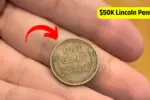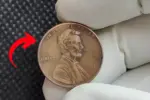The Lincoln Wheat Penny Valued at $653K : Coins are more than just currency; they are pieces of history that tell stories of the past. Among the most iconic and sought-after coins in the United States is the Lincoln Wheat Penny. While most of these pennies are worth only a cent, certain rare specimens have fetched astonishing prices at auctions, with some valued as high as $653,000. This blog explores the fascinating history, unique characteristics, and factors that contribute to the extraordinary value of the Lincoln Wheat Penny.
The History of the Lincoln Wheat Penny
The Lincoln Wheat Penny was first minted in 1909 to commemorate the 100th anniversary of Abraham Lincoln’s birth. It was the first U.S. coin to feature a president’s portrait, breaking away from the tradition of using allegorical figures. Designed by Victor David Brenner, the obverse side of the coin features a profile of Lincoln, while the reverse showcases two wheat stalks framing the words “ONE CENT” and “UNITED STATES OF AMERICA.”
The coin was minted until 1958, after which it was replaced by the Lincoln Memorial design. During its nearly 50 years of production, the Lincoln Wheat Penny became a staple of American currency and a favorite among collectors.
What Makes the Lincoln Wheat Penny So Valuable?
While most Lincoln Wheat Pennies are worth only their face value, certain factors can elevate their worth to staggering amounts. Here are the key elements that make some of these pennies so valuable:
1. Rarity
The rarity of a coin is one of the most significant factors influencing its value. Certain Lincoln Wheat Pennies, such as the 1943 Copper Penny, were produced in extremely limited quantities due to minting errors or unique circumstances. These rare coins are highly sought after by collectors.
2. Minting Errors
Minting errors can turn an ordinary coin into a valuable collectible. For example, the 1943 Copper Penny was mistakenly struck on bronze planchets instead of the steel planchets used during World War II. This error has made it one of the most valuable Lincoln Wheat Pennies, with one specimen selling for $653,000 at auction.
3. Condition
The condition of a coin, often graded on the Sheldon Scale, plays a crucial role in determining its value. Coins in mint or uncirculated condition are worth significantly more than those that show signs of wear and tear.
4. Historical Significance
Coins from specific years or with unique features often carry historical significance, adding to their appeal. For instance, the 1909-S VDB Penny, which features the initials of designer Victor David Brenner, is a prized rarity.
The $653K Lincoln Wheat Penny: A Closer Look
The Lincoln Wheat Penny that fetched $653,000 at auction is a testament to the allure of rare coins. This particular penny is a 1943 Copper Penny, one of the few known to exist. During World War II, copper was reserved for military use, and pennies were made from zinc-coated steel. However, a small number of copper planchets were accidentally used, resulting in this rare and valuable coin.
The $653,000 price tag reflects the coin’s rarity, historical significance, and excellent condition. It serves as a reminder that even the smallest objects can hold immense value.
How to Identify a Valuable Lincoln Wheat Penny
If you’re lucky enough to come across a Lincoln Wheat Penny, here are some tips to determine if it might be valuable:
- Check the Date and Material: Look for rare years, such as 1943, and check if the coin is made of copper instead of steel.
- Look for Mint Marks: Coins with mint marks like “D” (Denver) or “S” (San Francisco) can be more valuable.
- Examine the Condition: Coins in pristine condition are worth more. Look for signs of wear and tear.
- Seek Professional Appraisal: If you suspect you have a rare coin, consult a numismatic expert for an appraisal.
Why Are Rare Coins Still in Circulation?
Despite their high value, rare coins like the $653K Lincoln Wheat Penny can still be found in circulation. This is because they often look similar to ordinary coins and can go unnoticed. Many people are unaware of the potential value of these coins, leading them to remain in circulation.
Conclusion
The Lincoln Wheat Penny is more than just a coin; it is a piece of history that continues to captivate collectors and enthusiasts. While most of these pennies are worth only a cent, rare specimens like the $653K Lincoln Wheat Penny remind us of the incredible stories and value hidden in everyday objects. So, the next time you come across a penny, take a closer look it might just be a treasure waiting to be discovered.
F&Q
What is the Lincoln Wheat Penny?
It’s a U.S. coin minted from 1909 to 1958, featuring Abraham Lincoln’s portrait on the obverse and two wheat stalks on the reverse.
Why are some Lincoln Wheat Pennies so valuable?
Rarity, minting errors, condition, and historical significance can all increase a coin’s value.
What is the most valuable Lincoln Wheat Penny?
The 1943 Copper Penny, with one example selling for $653,000 due to a minting error.
How can I identify a valuable Lincoln Wheat Penny?
Look for rare years like 1943, check the material (copper vs. steel), and examine the coin’s condition.
Why are rare coins still in circulation?
Rare coins often look like regular coins, and many people don’t realize their value, so they remain in circulation.



